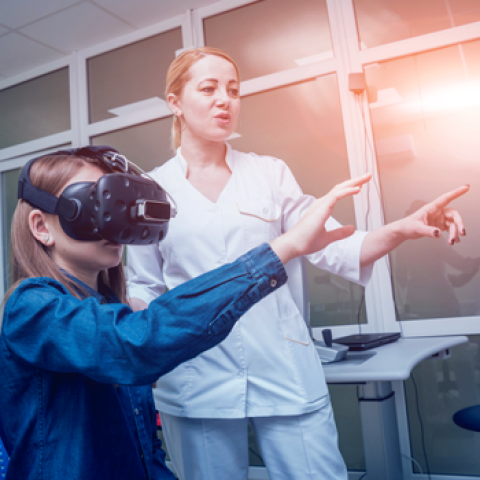Interdisciplinary Initiatives Program Round 9 - 2018
Anthony Norcia, Psychology
Alfredo Dubra, Ophthalmology
Gordon Wetzstein, Electrical Engineering
Scott Lambert, Ophthalmology
There are a number of ophthalmological disorders in which the ability to steadily and accurately point the two eyes at the same point in space is disrupted. The goal of this proposal is to develop optical prosthetic devices that can work in real-time to restore normal retinal image formation in patients who cannot adequately control their eye movements on their own. The most common oculomotor disorder of this type is strabismus (“crossed eyes”). In strabismus, the two eyes point in different directions and this leads to double vision. In children with strabismus, the brain develops an active neural compensation by which one eye takes over fixation and inhibits responses in the non-fixating eye. This chronic imbalance of inputs to cortex causes a loss of binocular function and frequently a loss of visual acuity (amblyopia) that is permanent if not treated during childhood. Common approaches involving surgical correction and vision therapy frequently fail to restore normal visual function. Recent treatment approaches based on active binocular training with video games or movie content have shown promise in laboratory studies, but larger trials have failed to demonstrate superiority over conventional treatments. Treatment failures are typically ascribed to a lack of compliance with the training procedure. We believe that another factor – residual small amounts of strabismus leading to uncorrelated activation of binocular cells during training may be at play. We propose to develop two approaches that will optically realign the two eyes in such a way as to restore normal patterns of binocular input. In one approach, we will build a retinal imaging system that can track each eye’s pointing direction with high precision. These signals will be used to control the presentation of a Virtual Reality display in such a way that the two eye’s images are always precisely located on the correct anatomically corresponding locations in each eye. In the second approach, electronically controllable prisms will be used to shift the retinal images in such a way as to compensate for the strabismus. The prism-based system will provide a form of Augmented Reality in which images of the real world are artificially and correctly aligned by the device. Once the devices are developed and documented to create accurate retinal image alignment and stabilization, we will apply for funding to mount a clinical trial in strabismus patients that would compare visual training with conventional approaches to new approaches that use our prosthetic stabilization devices. Our prosthetic approach would also be applicable in patients with nystagmus, a type of rapid jerky eyemovement common in albinism and several congenital oculomotor syndromes. To implement these new approaches, experts in vision science, optics, visual display design and ophthalmology will work together to develop and test the devices on normal vision participants and on patients with oculomotor disorders.





